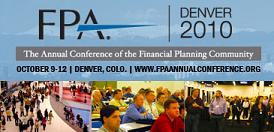Today wrapped up the final day at FPA Denver 2010. Despite the hard rain falling outside in the morning, attendee energy was high as the final two educational tracks were conducted before the conference’s conclusion. Here are my highlights from the final day.
I attended the panel discussion on rebalancing software moderated by David Drucker of Technology Tools for Today. Panelists included Damon Deru of Nine Mile Software (makers of TradeWarrior), Jinnan Zhou of Morningstar Office, Matt Springer of Tamarac Inc., and Ben Welch of TD AMERITRADE Institutional’s iRebal.
The introductions by a few presenters were fairly lengthy, so it cut down on the time Drucker had to challenge each vendor regarding their respective software platforms. Here are some of the answers from the panelists on select questions.
Cost Basis
All programs currently support lot identification when creating trades, and Tamarac and iRebal expect to coordinate lot accounting information with custodial trading systems to facilitate cost basis tracking requirements coming in 2011.
Success Stories
Welch shared an iRebal success story where an advisory firm grew from managing $200 million in AUM to $400 million via organic growth and acquisitions without having to add staff to manage increased trading. Springer’s success story on Tamarac featured one solo advisor strictly doing asset management for clients who grew to manage $700 million. It used to take this advisor three months to rebalance accounts without software, but the time was reduced to just one day after the addition of Tamarac.
Deru shared a similar story about TradeWarrior regarding a new breakaway broker using TradeWarrior to significantly cut down the time the firm spent rebalancing accounts.
Settlement Dates
When asked about differing settlement dates when trading mutual funds, Tamarac and iRebal support the addition of “hold dates” to delay a fund purchase until after settlement of a corresponding sale. This allows advisors to avoid incurring margin interest due to uncoordinated settlement. If I understood the panelists, Morningstar Office and TradeWarrior recommend that a trade file be generated but not submitted to the custodian until after the settlement date of the fund sales.
Options
All programs can account for “alternative positions” that are manually entered into the programs, including options. The alternatives are used to determine asset allocations, but no trades are generated for the option positions.
Pricing
According to each company’s representative, here are ballpark annual costs for the software:
- The minimum fee to purchase iRebal is approximately $20,000.
- Tamarac’s minimum is around $10,000 and they feature a “growing advisor” incentive for smaller firms (in terms of AUM).
- Morningstar Office rebalancing is offered somewhere between $5,000 and $10,000.
- TradeWarrior’s pricing is approximately $5,000
(if you represent any of the firms, let me know about more accurate pricing)
Onboard Process
As iRebal’s market focus is on larger, more customized asset management firms, they estimate that the average implementation time is three months from sign up to full production. Tamarac estimates the training and installation process to last between 30 and 60 days. Tamarac also offers a two day university training program to all new firms.
Morningstar Office can be implemented in about thirty days, and TradeWarrior’s setup and training lasts about two to three weeks.
In all cases, advisors can streamline process by preparing model portfolios and rule preferences in advance.
That wrapped up the session, and I missed the final track block in order to check out, eat, and head to the airport (where I put the final touches on this post using WordPress for iPad).
I hope you enjoyed the conference updates and got a good feel of this year’s event. I’m looking forward to next year’s conference in San Diego already!






